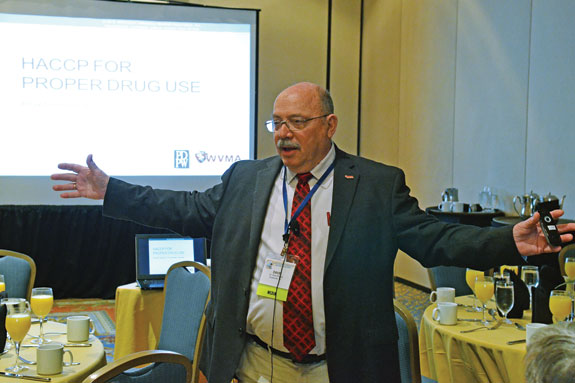Earlier this year, Dr. Dave Rhoda, a Wisconsin veterinarian, shared treatment protocol planning with a group of dairy and beef producers at the beef checkoff’s annual Dairy Producer Communications breakfast at the Cattle Industry Convention in Tampa, Florida.
Rhoda has been working with the Wisconsin Veterinary Medical Association (WVMA) to address drug use on dairies and to encourage dairy producers to have a “mindset shift” when it comes to treatment protocols.
The WVMA started its drug usage work in 1996 when the Animal Medication Drug Usage Clarification Act (AMDUCA) became law and the WVMA has continued with the Hazard Analysis & Critical Control Points (HACCP) plan to organize drug usage on dairies.
“We’ve been developing a HACCP plan for drug uses on our dairies relative to drug residues,” said Rhoda. “As new technology comes online, it heightens the amount of meat inspection being done, and now milk inspection.
So consequently, as we get new information, we find out where mistakes are being made and then create a plan for solutions.”

Veterinarian-client-patient relationship
Rhoda emphasized that drug residues are a “people problem” – somebody made a mistake.
He noted that the VCPR – veterinarian-client-patient relationship – is top priority and that those two groups need to be communicating and to understand their roles and responsibilities for each unique dairy.
He also noted that for producers located hundreds of miles from their veterinarian, this relationship is still vital.
“It’s very important we have a team approach. Regardless of how far apart we are in distance, the trick is that everyone has a concept of what is happening.
“Each and every producer should want to find opportunities to improve, and then take the necessary action to do so. Anybody who thinks we can’t improve isn’t looking. We can be satisfied for the moment, but we will always be seeking to improve for today’s consumers,” states Rhoda.
The work of the WVMA has always been driven by the thought that more regulation is not the answer because the agricultural community and farms in the U.S. are so diverse and unique. The work has to be done one farm at a time.
The WVMA has four steps to proper treatment protocols:
1. Having a defined condition – the person who is going to be using drugs must know the exact use.
2. Once the defined condition is identified, develop the proper drug response treatment which matches the specific protocol.
3. Set up the records properly and record protocol activity.
4. Know exactly what food withdrawal times are for that protocol and who is responsible for knowing when that treated animal can again become a food-producing animal.
“From the beginning, we said this is not something where we can write more regulations, or where we can check boxes and be satisfied that what needs to happen will,” Rhoda said.
“This needs to be an action plan that includes the people involved with the veterinary-client-patient relationship. We need to develop a plan where the necessary actions are performed on that farm to be confident there are no residues.”
Has there been improvement?
Some of the first people to take note of the WVMA’s work was the Food and Drug Administration (FDA) in Washington, which was a positive step forward.
But beyond the FDA, dairy producers were also taking notice.
“People are serious about this. Our agricultural community already places food safety, food quality and food quantity at the top of their priority lists,” Rhoda said. “This is something producers want to do, and we simply offered a viable plan on how to do it.”
The checkoff’s Beef Quality Assurance (BQA) work is very much a part of what has happened with drug usage issues on dairies. In line with past National Beef Quality Audit results, the WVMA work initially centered around tissue residues.
Since audit results have shown continued improvements made by dairy producers when it comes to tissue residue and proper injections, the priority has shifted more toward putting together the HACCP plan that works for the drug usage in any food animal.
The message to consumers
Rhoda’s message to producers is one they can take back to consumers. “We’re not really doing this because there are major issues.
We are doing this because there is an opportunity to do better. And we are doing this because the consumer has expectations of us and we want to meet those expectations.” PD
Visit their website for more information about the Dairy BQA program.
PHOTO
During a recent presentation, Dr. Dave Rhoda emphasized that drug residues are a “people problem” – somebody made a mistake. Photo provided by Melissa Slagle.
Melissa Slagle
Trade Media Manager
Cattlemen’s Beef Board





